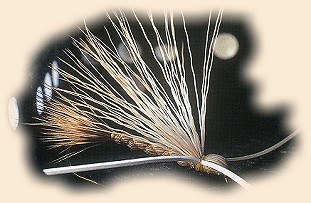The Madam X
By Skip Morris
Not long after the Madam X made its debut in Doug
Swisher's videotape, "Tying Attractor Flies," I
happened to be standing in a trout stream with a
friend who began raving about the deadliness of
this peculiar new dry fly. "The fly shop's out of
it again," he said, as if to validate his account.
Still uncertain I was properly impressed, he added,
"They just can't keep it in stock!"
Few flies burst onto the scene with such bravado. I
was impressed...but, it seemed, so was everyone else.
Everyone still seems impressed with the Madam X.
Just who created the Madam X I'm not sure. Doug Swisher
probably developed the fly, and is usually given credit
for it, but in his video he never plainly says so.
He does say that he was "almost afraid" to tell anyone
about the Madam X for quite a while. It is an alarming
trout fly, with its crisscrossed ribs, thick tail, and
gangly cross of legs. He finally did tell because the
Madam X kept catching trout. Doug says that he usually
fishes it along stream banks and back under overhanging
grasses and cut banks. He fishes it either dead drift or
with twitches. When a trout takes a Madam X, he says, the
result is "usually explosive." Its long springy legs may
be what sets the Madam X apart from other attractor dry
flies; Doug says that because of those legs, the fly
"vibrates."
There is nothing particularly delicate or graceful about
the Madam X; it has more the coarse bulk of a bass bug
than the intricate lightness of most trout flies. Doug
completely eradicates any possible resemblance to a
normal dry fly by tying it on really big hooks. He
explains his choice of hook on the videotape: "Fish
like a big bite, not a small bite," he says.
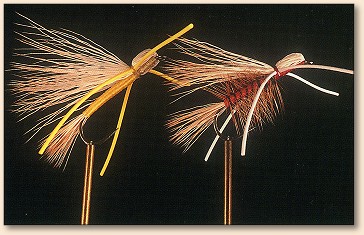
Variations: on the left, a Madam X with an all-floss body
(and the yellow legs Skip often substitutes for the
standard white); on the right, an orange version with a
saddle hackle palmered up the body.
Most popular fly patterns spawn a seemingly endless
procession of variations who hasn't seen a dozen
versions of the Woolly Bugger? In general, this is
a form of flattery; without question, it signals a
fly's popularity. Some of the fly-pattern books in
my collection describe Madam Xs with bodies of a
solid layer of thread or floss over the deer hair,
instead of the original spiraled thread-crosses up
a deer-hair body. Others list orange thread as an
option to replace the standard yellow. I've even
seen a pattern with a brown hackle palmered up the
body. My own touch is to use yellow rubber-strand
legs in place of the standard white.
I'll show you how to tie the Madam X as I tie it,
my personal style, though this fly's form largely
dictates the method of its tying.
Materials for The Madam X:
Hook: Light wire, 2X or 3X long, sizes 8 and 6.
Thread: Yellow 3/0.
Body and Tail: Natural deer hair (or elk).
Wing and Head: Natural deer hair (but I prefer elk hair,
because it makes a tougher head).
Legs: Round white rubber-strand.
Tying Instructions:
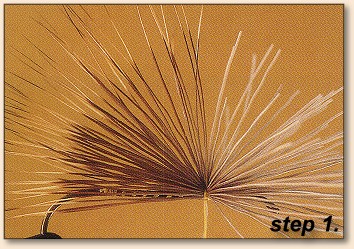
1. Start the thread at the hook's bend; then wind it
tightly up two thirds of the hook's shank. Comb and
stack a small bunch of deer (or elk) hair. Bind the
hair by its butts at the two-thirds-up-the-shank point.
The hairs' tips should extend beyond the rear of the
shank a distance roughly equal to the hook's gape.
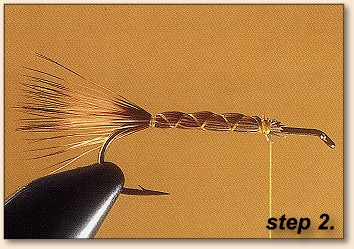
2. Trim the butts closely. Hold the hair down around
the shank as you wind the thread down the hair in
tight open spirals to the bend. At the bend, add
two turns; then spiral the thread back up to the
front of the hair. Take a few tight thread-turns
at the front of the body to lock the spiraled turns
in place. The hair-body should now have a pattern of
thread-Xs along it.
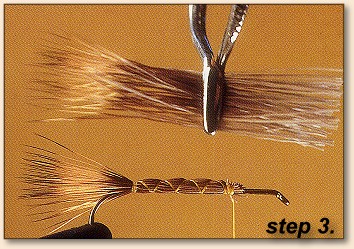
3. Comb and stack another small bunch of deer (I use
elk) for the head and wing. Hold the hair so that its
tips are even with the tips of the tail; then cut the
hair's butts straight across about 1/4 inch beyond the
hook's eye.

4. Bind the hair, by its butts, from the eye back to
the front of the body. The tips of the hair should
point forward, over the hook's eye. Try to keep the
hair entirely atop the hook's shank as you bind it on.
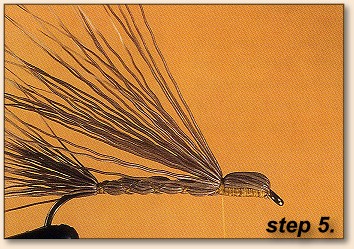
5. With the thread hanging at the front of the body,
stroke the wing-hair up, and then pull it back and
down. Bind the hair in place with a few tight
thread-turns. You now have a wing and a sort of half
bullet-head, both atop the hook. Ideally, the wing's
tips should be even with the tail's tips.
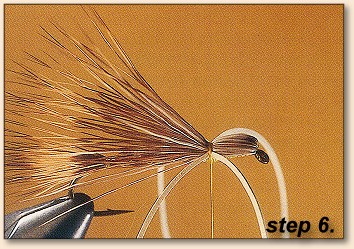
6. Bind a short length of rubber-strand along each
side of the thread collar with tight thread-turns
at the rear of the head. Draw back the legs and
whip finish the thread just in front of them. (Doug
prefers to whip finish the thread at the hook's eye,
in front of the bullet head.) Trim the thread.
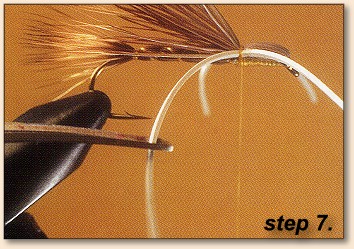
7. Trim the legs long for example, when the rear
legs are pressed back against the sides of the fly,
they should reach to the tips of the tail, or even
slightly beyond. Add head cement to the whip finish.
~ Skip Morris
Credits:
The Madam X is an excerpt from Skip Morris' book,
Morris on Tying Flies. Skip has taken
his favorite patterns and updated them with new materials
and techniques. An excellent book, published by
Frank Amato Publications.
|

